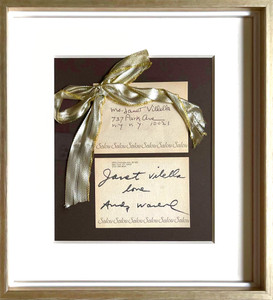
Andy Warhol
Marilyn, Tokyo Japan, 1983
This is the original poster for Andy Warhol's 1983 exhibition at the Art Center Hall in Tokyo Japan. It is especially collectible as it was printed in Warhol's lifetime, for an exhibition during his lifetime. We don't know how many were originally printed, but they are rarely found stateside (or anywhere in the world) and the Art Center Hall on the Ginza no longer exists. The uneven black ink on Andy Warhol's printed name is part of the original manual silkscreen printing process and not a flaw. All of the posters have the same gradations to the text. (It is deliberate and not fading.)
In November of 1962, Andy Warhol exhibited his candy-colored paintings of Marilyn Monroe at Eleanor Ward’s Stable Gallery in New York, to great critical and commercial success that catapulted him to international superstardom. Five years later, as the Factory was in full swing and his celebrity status reached around the globe, Warhol again selected Marilyn Monroe as the inaugural image for a new print portfolio that would be published through his own company, “Factory Additions.”
Rather than opting for verisimilitude, Warhol’s Marilyn is vividly-colored, in wild combinations that evoke the psychedelia of the era, revealing the confidence of a mature artist at the height of his powers. Rendered in a heady Pop palette of green, yellow, red and blue, Marilyn celebrates its subject's glamorous life, but hints at the ephemeral nature of fame and fortune, a subject that would haunt the artist for the duration of his career. Warhol seems to convey her star power and the effect of her celebrity persona in supernatural terms, elevating her status from star of the silver screen to modern-day icon. Warhol’s close friend and confidant, David Bourdon, wrote: "Warhol's Marilyn silkscreens are even more vivid and lurid than his earlier portraits of her on canvas. He chose lush, non-naturalistic colors, with the blazing hues in startling combinations. … From the beginning, Warhol's Marilyns were considered the most desirable of all his prints. For a few years, it was virtually impossible to make the rounds of savvy art collectors' homes without encountering Marilyns at every turn. Their initial popularity was due in large part, of course, to Monroe's enduring appeal. But the prints' artistic staying power is due to Warhol's audacious originality as a colorist" (D. Bourdon, Warhol, New York, Abrams, 1995, p. 26).
Warhol loved the mix of glamour and tragedy that Monroe personified, and upon learning of her death, he immediately set to work on her portrait. The lively coloration of Warhol’s portrait hints at the artifice behind the star’s made-up, silver-screen persona that masked her true identity and the humble origins from which she rose to great fame. An expert colorist, Warhol combines audacious colors in an unlikely grouping that ironically lends a striking sense of realism to the piece, hinting at a truer understanding of Monroe’s complicated personality than a realistically-rendered portrait could. The catalogue raisonné of Warhol’s prints describes this phenomenon: “However Warhol intended his portraits to be seen—as vanitas images, history painting, or simply glamour poses—he did more than any other artist to revitalize the practice of portraiture, bringing renewed attention to it in the avant-garde world. He reflected the desires and dreams of a new decade" (C. Defendi, F. Feldman and J. Schellmann, Andy Warhol Prints: A Catalogue Raisonné 1962-1987, New York, 2003, p. 23).
Measurements:
Framed:
31 inches by 21 inches by 1.25 inches
Print:
29.5 inches vertical by 20 inches











